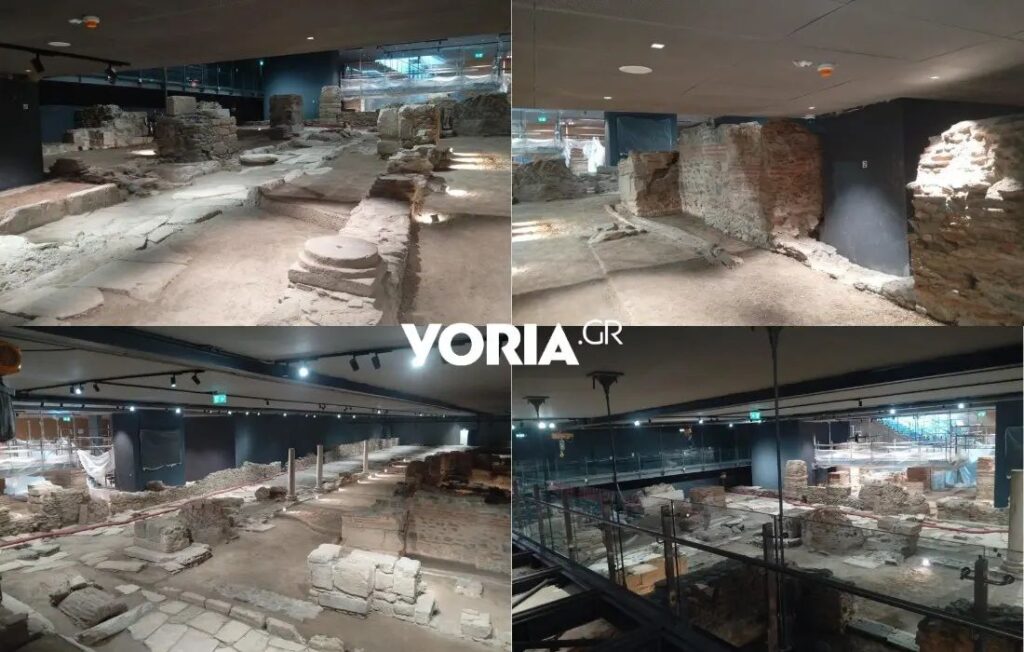

This archaeological treasure trove unveils Thessaloniki’s history from its founding by Cassander in the late 4th century BC to the early 20th century.
The Ministry of Culture and Attiko Metro promise the world’s largest archaeological site integrated within a major infrastructure project. Thessaloniki residents eagerly anticipate descending into the depths of Venizelos station for a journey through time, from Byzantine to Hellenistic eras.


The Roman Decumanus Maximus, the Byzantine Middle Road, today’s Egnatia Street, lies revealed, complete with its ancient water supply system, baths, shops, columns, and arches, showcasing Thessaloniki’s historical grandeur.
The Ephorate of Antiquities of Thessaloniki and the Ministry of Culture have kept the archaeological site tightly under wraps, but this station’s story is anything but ordinary. Its 17-year journey reflects a city divided, with protests erupting over the fate of the unearthed treasures. Memories linger of all-night vigils, flickering candles, and banners proclaiming “Crime at Venizelos,” some still visible on apartment balconies. The cry of “Crime at Venizelos” eventually transformed into “Both Metro and Antiquities,” but not without difficulty, delay, and expense.
From Excavations to Impasse (2007-2019)
Construction of the 76.6m long, 19.75m wide Venizelos station began in 2007. Initially designed to reach a depth of 27m across four underground levels, early work focused on earthmoving. In 2012, excavations unearthed the monumental crossroads of the Decumanus Maximus and Cardo, corresponding to the modern intersection of Egnatia and Venizelos streets. This discovery sparked a protracted debate.
The construction consortium faced financial difficulties, compounded by the controversy surrounding the preservation of the antiquities. In December 2014, the Central Archaeological Council (KAS) reviewed six proposals, ultimately recommending the temporary removal and subsequent reinstatement of the artifacts. Then-Mayor Yannis Boutaris, backed by segments of the archaeological and scientific community, challenged the decision in the Council of State, demanding the antiquities remain in situ.
In October 2015, under the new Syriza government, Culture Minister Aristides Baltas decreed the in-situ preservation of the antiquities. Despite negotiations, Attiko Metro and the contractor failed to find a workable solution, even raising the possibility of abandoning the station altogether.
The period from 2015 to 2019 saw the Venizelos station project stagnate. While the “study for the construction of the station with in-situ preservation and showcasing of the antiquities” was approved in February 2017, progress remained stalled. By December 2019, KAS members noted the lack of substantial advancement and criticized the inadequate basis of the 2015 in-situ proposal.
A Turning Point (2019-2020)
The December 2019 KAS meeting, under the new Mitsotakis government, proved pivotal. Attiko Metro President Nikos Tachiaos stated that while the 2015 mandate called for in-situ preservation, engineers deemed it unsafe. After a marathon session, KAS recommended the removal and reinstatement of over 92% of the antiquities, a decision ratified by the Ministry of Culture in March 2020.
This decision reignited public debate. International and Greek academics, along with concerned citizens, protested the removal. Renowned historian Angelos Chaniotis spearheaded a global petition urging Prime Minister Mitsotakis to preserve the Byzantine crossroads. Despite continued opposition, the Ministry of Culture proceeded with its plan, restarting excavations and construction.
Unearthing Thessaloniki’s Past (2020-Present)
Post-2020 excavations, reaching depths of 9 meters, unveiled Roman and Hellenistic-era artifacts, including a section of the Decumanus Maximus at its intersection with the Cardo, the site of the ancient Tetrapylon. This crucial crossroads marked the city’s main artery, connecting the Golden Gate (present-day Demokratias Square) to the Kalamaria Gate. Excavations also revealed densely built Byzantine shops lining the Middle Road, alongside numerous gold and silver artifacts attesting to vibrant commercial activity. Furthermore, approximately 5,000 tombs, some containing gold grave goods, along with mosaic floors, marble and plaster decorations, and over 3,000 artifacts spanning six centuries of Byzantine history, were discovered.
Further discoveries in 2022 illuminated aspects of the city’s social and economic life between the 4th and 11th centuries AD, including architectural remains of buildings near the Bezesteni, possibly connected to a public bath complex featuring a mosaic floor with the inscription “ΩΡΟΦΟΡΟC” (Orophoros – “roof bearer”).
A Station and a Museum
The 1,260 sq.m. Venizelos station, built upon excavations covering at least 3,500 sq.m., will serve 65,000 passengers daily. The extensive archaeological works across all metro stations, costing over €175 million, have yielded more than 300,000 artifacts, many of them unique and rare. Venizelos station promises to be not just a transportation hub, but a remarkable underground museum showcasing Thessaloniki’s rich and layered past.
JP Morgan has raised its U.S. recession probability from 40% to 60%, now fully anticipating…
European Parliament President Roberta Metsola reaffirmed the EU’s commitment to supporting Cyprus’ reunification during a…
A young Scottish couple was rescued from Prombona Stream between Chalkidona and Nea Filadelfeia after…
An Afghan national has been ordered into pre-trial detention as a suspected smuggler following the…
Wall Street suffered a historic $5 trillion loss in just two days, with the Dow…
On April 4, 2025, the U.K. Office of Maritime Trade Operations reported that vessels in…